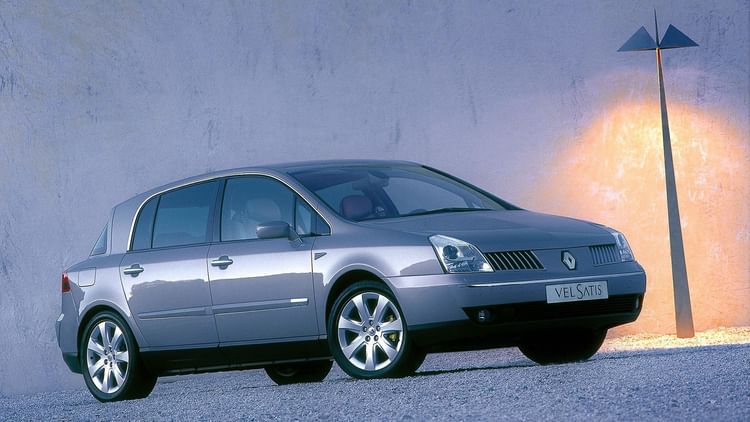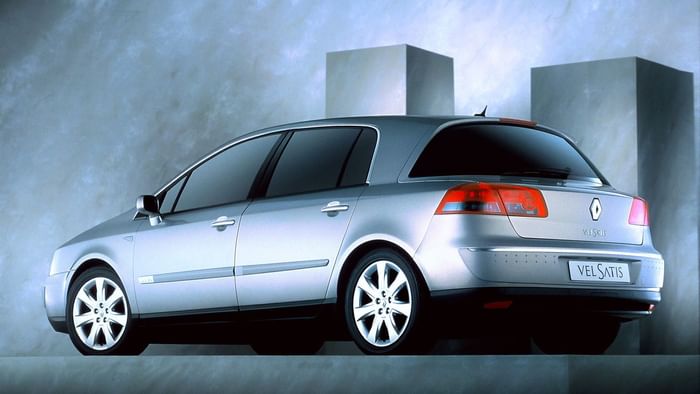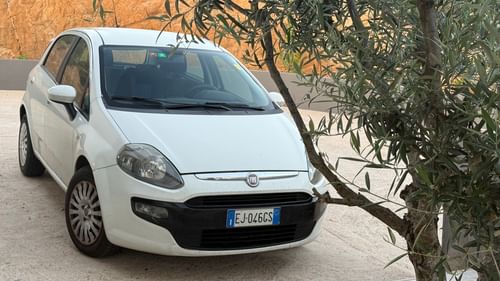
The Renault Vel Satis is what happens when a French car company is told that its current flagship isn’t French enough. How else do you explain Renault’s two-pronged attack on the premium executive segment, which delivered the Avantime and Vel Satis? A form of automotive colonic irrigation to erase the memories of the perfect-in-every-way Renault Safrane, a car that is beyond reproach. Not our words, etc…
Sales started in 2002, two years after the demise of the Safrane, with Renault sending the Vel Satis into a market dominated by the ‘big three’ of the large executive market, namely the Mercedes-Benz E-Class, BMW 5 Series and Audi A6. All three had enjoyed sales of more than 100,000 units in 2001, while the Volvo S70/V70, Saab 9-5, Jaguar S-type and Volvo S80 enjoyed smaller but significant slices of the Euro exec pie. The Jag’s retro styling and Saab’s famously idiosyncratic approach aside, these are cars known for their conformity and traditional idea of what makes a premium car buyer go weak at the knees. Soft-touch materials, sombre cabins, understated styling and suspension configured to while away a few hours on the outside lane of a European motorway. A 600,000-unit per annum market the Safrane failed to crack.
Renault spent €350m developing the Vel Satis, predicting total sales of 300,000, running at an average of 50,000 a year before the car’s expected departure in 2008. For context, Safrane sales totalled 21,335 in 1999 and 13,180 in 2000. By the end, around 62,000 Vel Satis had been built, with fewer than 1300 finding homes in the UK. Louis Schweitzer, chairman of Renault, said that the development costs were kept to a minimum to ensure the Vel Satis could be profitable at low volume – a comment he would live to regret. A decade ago, Bernstein Research published a study that named Europe’s biggest loss-making cars, headlined by the Smart Fortwo (issue 2), Fiat Stilo and Volkswagen Phaeton. The Vel Satis was number ten, with the brokerage estimating that the car lost €1.2bn with a per-unit loss of €18,712. Come back, Safrane, all is forgiven.
Should we be surprised by its commercial failure? The Vel Satis – a combination of VELocity and SATisfaction, but also Latin for ‘or enough’ – was a bold design, even by Patrick le Quément’s standards. Perhaps design commentator Stephen Bayley had the Latin translation in his mind when he described the car as ‘not ugly enough’, but Le Quément wanted it to stand out from the crowd. The conservative Safrane hadn’t worked so why not go for broke? Yes, ‘broke’ is a questionable choice of word when talking about French cars of the 1990s and ’00s…

Few were able to look beyond the car’s challenging styling, which meant they missed out on an interior brimming with neat details, including soft leather, wood trim, an analogue clock, and asymmetrical front seats to provide a better view for those lucky enough to be travelling in the back. If you need evidence of the Vel Satis’ generous headroom, look no further than Her Majesty the Queen’s visit to France in 2014. She was due to travel in President Francois Hollande’s Citroën DS5 or C6 without squashing her headwear, so an armoured Vel Satis was removed from hibernation for use during the D-day commemorations. Reviewing the big Renault for What Dignitary Car? magazine, Her Majesty probably praised the hat room, the pace of the Nissan-sourced 3.5-litre V6 engine and the light and airy cabin. In the ‘cons’ column, she almost certainly noted that the ride quality wasn’t up to the standards of other French cars she had travelled in, questioned the residual values, and said that the 2.0- and 2.2-litre petrol engines were a little underpowered for a 1.73-tonne executive car. For towing duties, she ‘d have recommended the Isuzu 3.0-litre V6 24-valve diesel, a view echoed by The Caravan Club.
In many ways, the Vel Satis made more sense than the Avantime, but its challenging styling and dominance of German brands in its target segment meant that it was doomed to failure. It may not have been the king of the executive class, but the Vel Satis proved that it was fit for a queen.
This article first appeared in issue 24 of Classic.Retro.Modern. magazine.





